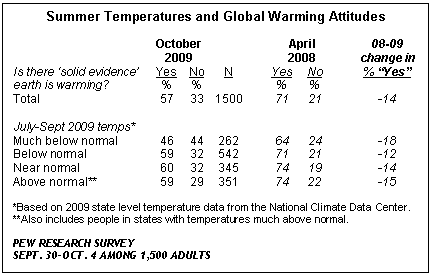A recent Pew Research survey showing a sharp decline in the proportion of the public saying there is solid evidence of global warming has triggered considerable speculation about why these views are changing. The poll was released a day after 18 leading scientific organizations released a letter reaffirming what they see as scientific consensus on climate change.
The survey found 57% saying there is “solid evidence that the average temperature on earth has been getting warmer over the past few decades.” In April 2008, 71% said there was solid evidence of global warming, and in 2006 and 2007, 77% expressed this view.
Why do fewer Americans believe the earth is warming? No single factor emerges from Pew Research Center surveys, but rather a range of possible explanations, including a sour economy and, perhaps, a cooler than normal summer in parts of the United States.
First, it is important to note that signs of a change in public opinion — on the environment generally and global warming more specifically — were evident long before Pew Research’s new survey. In March, Gallup’s annual environment survey found an increase in the percentage of Americans who say the seriousness of global warming is “generally exaggerated” — from 30% in 2006 to 41% this year. Similarly, Fox News found the percentage of registered voters saying they “believe global warming exists” has fallen from 82% in January 2007 to 69% in May of this year.

Pew Research surveys show that as economic concerns have surged, fewer people view the environment as a top policy priority. In our annual survey on the public’s policy agenda, just 41% rated protecting the environment as a top priority; just a year earlier, 56% rated it as a top priority. Yet other issues also were overshadowed as more people focused on the economy and jobs. There were sharp declines as well in the proportions rating dealing with illegal immigration (down 10 points), reducing health care costs (10 points) and reducing crime (eight points) as top priorities for the president and Congress.

Notably, there has been no change in recent years in the proportion of the public saying that stricter laws and regulations are needed to protect the environment. Fully 83% expressed that view in Pew Research’s political values survey, released in May. At the same time, far fewer people viewed protecting the environment as a priority if it meant slower economic growth and job losses, or higher prices.
Continuing Global Warming Concern

Even as concern over global warming has flagged, however, it remains widely shared. In Pew Research’s recent survey, 65% described global warming as a very serious (35%) or somewhat serious (30%) problem. In April 2008, 73% said global warming was either a very serious (44%) or somewhat serious (29%) problem.
Notably, even a third of those who say there is no solid evidence of global warming — and an even larger percentage (65%) of those who say there is such evidence, but attribute global warming to natural patterns rather than human activity — view global warming as a very or somewhat serious problem.
Is Weather a Factor?
While the economic crisis may have had a role in the public’s shifting views on global warming, there also are other possible factors. For example, in some parts of the country this was an unusually cool summer — the National Climate Data Center classifies nine states, with roughly a sixth of the American population, as places with summer temperatures “much below normal.” People living in those states appear to be less likely than those living elsewhere (in states where temperatures were only somewhat below normal, near normal or above normal) to see solid evidence of global warming.

While this is an intriguing finding, Pew Research did not include it in the report because this may simply be a reflection of regional differences in perceptions about global warming that existed prior to the weather this summer. The nine states experiencing particularly cool summers in 2009 — mostly in the Midwest — were states where belief in the solid evidence of global warming was already somewhat lower in 2008. In other words, the rate of decline in the percent saying there is solid evidence of global warming was roughly equivalent irrespective of this summer’s weather.
A systematic study of the relationship between recent weather patterns and climate change attitudes is not possible using the Pew Research Center’s data because the surveys have been conducted at various times of year, rather than at the end of each summer.
What’s Ahead
A review of recent polling on global warming shows that results vary widely with differences in question wording. These opinions also are fluid: Gallup’s trend on whether news about the seriousness of global warming is generally correct, which goes back more than a decade, has fluctuated over the years. In 2004, 38% said that the seriousness of global warming had been “generally exaggerated” — nearly as many as said that in this year’s survey (41%). Looking ahead, it is possible that an improved economic climate or other factors — including changing weather patterns and the debate about environmental policy issues in Washington — could have an impact on the public’s thinking about this issue.